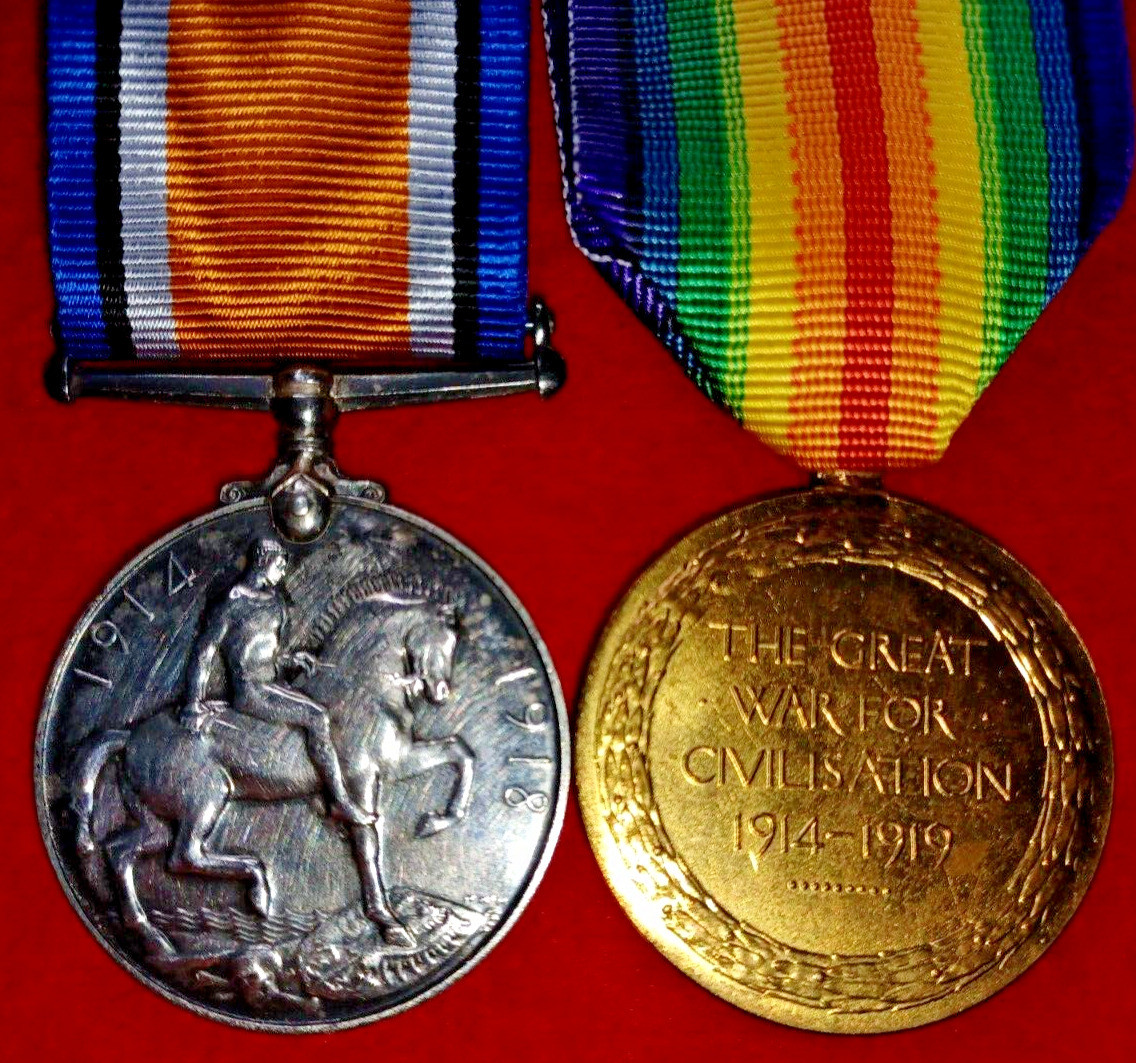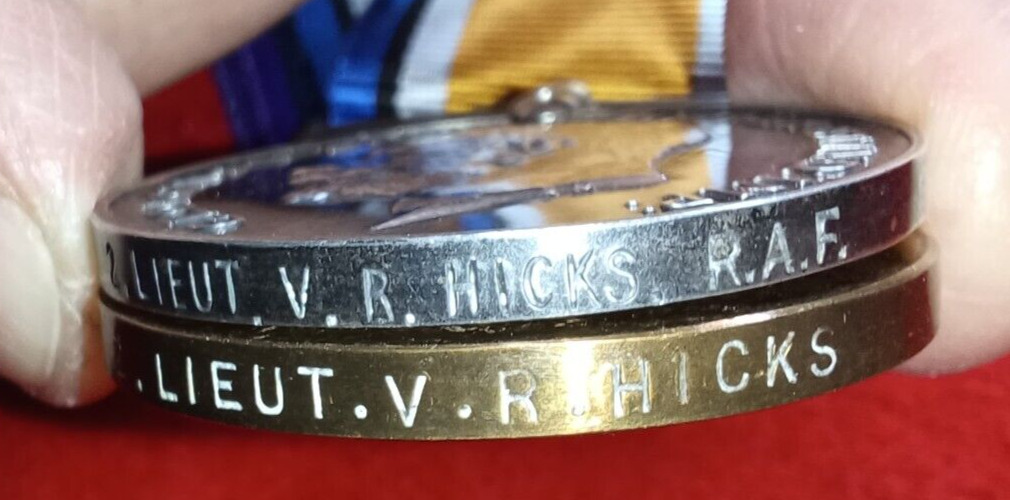-40%
WW1 Medal Pair to a Canadian Flight Lieutenant in the R.A.F. + Research, 7th Bn
$ 182.69
- Description
- Size Guide
Description
WW1 Medal Pair to a Canadian Flight Lieutenant in the R.A.F. + Research, 7th Battalion CEFNamed to : 2 LIEUT. V.R. HICKS. R.A.F. (
2 LIEUT. V.R. HICKS on Victory) see below :
2nd Lieutenant Valentine Richard Hicks
Valentine was born in Qu’Appelle Saskatchewan on 15 March 1896 but is recorded as being baptized at Enfield, in Middlesex almost a year later on 10 January 1897. The family had returned to England and were living there in 1901. However they were soon back in Canada and this time settled in North Vancouver British Columbia. In 1911 Valentine got a job as a clerk. He will attest to the Canadian Expeditionary Force on 18 September 1914. Private 16432 Valentine Hicks was placed in “B” Company of Vancouver’s 7th Battalion. It sailed for England on 3-4 October 1914 aboard the SS Ruthevia and in France served from February as part of the 2nd Infantry Brigade, 1st Canadian Division (1CD).
Only five months after arriving overseas, on 3 March 1915, the 1CD entered the line at Fleurbaix which was 5km south of Armentieres. On 1 April they moved to Flanders in Belgium to help the British defend the Ypres Salient around St. Julien. After 1CD sustained heavy artillery barrages and a massive gas attack by the enemy on 22 April, the resulting casualties and confusion suffered by 1st and 3rd Brigade meant that 2nd Brigade (held in reserve) was rushed to bolster the defense north of St. Julien. On the 24th it is recorded that “What was left of the 10th Battalion was deployed to Gravenstafel Ridge, and the beleaguered 8th Battalion got companies of the 5th (Western Cavalry) and 7th Battalion. The 16th was pulled back from Kitchener’s Wood to strengthen a new line being created by 3rd Brigade, and the 2nd were sent to replace them. Companies and even platoons were thrown into the fighting with little regard to where their parent unit was located, and for many hours ‘battalions’ were simply ad hoc groups of men in the same general location.” The Germans continued to push forward against the 3rd Brigade and units northeast of St. Julien and by mid-morning of the 25th the 7th Battalion was among the hardest hit “Its right-hand company had been all but destroyed in six hours of shelling, and the remainder was barely able to hold against the ever-increasing weight of the German effort.” With things getting desperate “The commanding officers of the 7th, 14th and 15th Battalions decided amongst themselves to withdraw to a new line 300 meters to the rear.” However, all were able to pull back “but the 7th Battalion was so closely pursued by the Germans that most of the men fell during the fighting withdrawal.” As the front line continued to bend under the German onslaught, “In the confusion and disorder, the integrity of the defense of the whole Division was now threatened. 2nd Brigade, meanwhile was still holding firm along its original front line as well as on Gravenstafel Ridge, but its left flank was now completely exposed. And the small garrison on the Ridge was exposed to direct fire from the positions the Germans had just taken.” (NOTE: We Stand on Guard. An Illustrated History of the Canadian Army. Ovale, 1992.) While things continued to look bleak, the Canadians were able to hold back the German assault. Soon fresh battalions emerged and the British will try to retake what was lost around St. Julien. Although that effort will fail, the line was stabilized and on 25 April the Battle of St. Julien ended. While 1st and 3rd Brigades were sent to the rear for rest and reinforcement, Valentine’s 2nd Brigade remained in the line until 27 April.
What is interesting is that Valentine is reported on one document in his file as being “Wounded” on 30 April 1915 after 1st Canadian Division had been entirely pulled from the line. The date given is actually when this information finally got to HQ or as stated in his record “Reported from Base.” In his Casualty Form the Commanding Officer of the No.# 3 Stationary Hospital records that on 25 April he received “Gun Shot Wound Knee,” and also suffered from “Suffocation.” What is bizarre is that the next day on the 26th the Officer in Command No.# 84 Field Ambulance records that Valentine suffered from a “Gun Shot Wound Head & Hand.” This is then repeated by the Commanding Officer of the No.# 3 Stationary Hospital on the 27th of April. Therefore one wonders how his wounds went from being a gunshot wound to his right knee and suffocation to gunshot wound head and hand? Was alcohol involved in the recording of his wounds? Obviously the amount of shell fire poured on to the 7th Battalion at the Battle of St. Julien meant that many were buried alive. This likely explains the initial diagnosis of “Suffocation.”
On 12 May he is at the Convalescing Depot at Rouen and No.# 3 General Base Depot. On 28 May he is “Taken on strength as attached from date following,” to General Headquarters (GHQ) and “Placed on Subsistence allowance from date following.” Then, on 23 June 1915 he is at No.#8 General Hospital at Rouen suffering from Pyrexia which is fancy talk for fever. A week later his is returned to duty by Officer Commanding General Hospital 3rd Echelon. He is back at GHQ Rouen on 31 July. On 13 October he is “Removed from his appointment as OR Clerk and attached as orderly.” On 12 December Valentine is “Transferred to No. 9 Stationary Hospital” at Le Havre suffering from Gonorrhea. From December to February 1916 he is at GHQ “in the field” still recovering however this morphs into a case of measles on 14 March 1916. He is then moved to the Isolation Hospital at Le Havre. He is discharged on the 25 March 1916. Oddly, he will come down with the mumps on 14 November 1916 and end up at the No.# 2 General Hospital. He will be discharged to duty on 4 December 1916.
On 23 May 1917 he is recorded as still being in 7th Battalion but “Attached to Canadian Section, 3rd Echelon GHQ” in the “Field.” On 30 June 1917 he is “Attached to Canadian Section 3rd Echelon.” Then, on 30 July 1917 he is graded as “Clerk Class II” and promoted on 30 October to “Clerk Class I.” On 5 December he is granted 15 days leave. On his return on 21 December it is recorded that he “Ceases attachment to Canadian Section 3rd Echelon GHQ’s on proceeding to HQs R.F.C.” On 28 December 1917 it states in Valentines pay records “Ceases to be attached on proceeding to RFC Pte. For Commission.” His Royal Flying Corps/Royal Air Force record states he was sent to South Farnborough on 28 December when in his Canadian Casualty Form it states on 30 December 1917 “Transferred to England & posted to British Columbia Regiment [7th Battalion] Depot Seaford for the purpose of being posted to Royal Flying Corps Depot Farnborough, pending transfer to RFC Cadet Wing.”
On 23 January 1918 he “Ceases on command RFC South Farnborough on Command to No. 2 Cadet Wing RFC Hastings.” On 28 January 1918 his RFC/RAF record states he was attached to No.# 2 Officer Cadet Wing. On 1 February 1918 he is at No.#1 Squadron No.#2 Royal Flying Corps Cadet Wing, Hastings. He is checked out by the Medical Officer on 14 and 16 February before being discharged from the Canadian Army. On 2 March he is deemed “Fit as Pilot.” On 9 March he is to attend the No.# 6 School of Military
Aeronautics at Denham. Then on 27 April he is sent to the Royal Flying Corps/RAF Armament School at Uxbridge and then on 25 May the Armament School at Stamford. He is appointed to be an Imperial Flight Cadet on 24 May 1918. On 18 August he is made a 2nd Lieutenant. Between May and 19 October 1918 he was at the No.# 1 Training Depot Squadron/35 Training Wing/3rd Training Group at Midland Wittering. He spends intermittent short stays in hospital while with No.#1TDS until he joins No.# 5 Training Depot Squadron at Midland Easton-on-the-Hill on 8 February 1919. At the end of March he joins 55 Training Squadron and then on 18 April 1919 he is “Transferred to the Unemployed List.”
Valentine was entitled to the 1914-15 Star, War and Victory Medal. His original 1914-15 Star is likely missing because it was sent to an address at which Valentine no longer resided. A duplicate 1914-15 Star was issued by the Canadian Government on authority dated 28 November 1921 and is lost. His War Medal was issued to him by the Air Ministry however his Victory Medal was issued via the Army. They state on 27 September 1922 “Duplicate Victory Medal to H6303 Pte. M. Francis (B15688) to be re-engraved for this man.” This is the reason why his War Medal indicates his service in the Royal Air Force while his Victory Medal, in typical Army fashion, only has his rank and name.
In September 1919 Valentine married Alice Gertrude Burrows and they had a son Alastair David Seacome Hicks in 1921. They also had another son Lawrence who died and a daughter named Imogen. They lived at Notting Hill, London. Unfortunately Valentine and Alice will divorce by 1931-32. He will marry again in 1939. At that time he was serving as a Pilot Officer. As of September 1939 he was with the Royal Air Force Volunteer Reserve under “Administrative and Special Duties Branch.” By 19 January 1940 he was a Flight Lieutenant. This service entitled him to at least the bare minimum of War and Defence Medals and possibly the 39-45 Star. So far there is no indication of service outside of the UK.
At the outbreak of war, or possibly even earlier, his son followed in his father’s footsteps and joined the RAF and received the service number 40911. Sadly that led to his death when he was flying, as pilot, Bristol Blenheim IV (Z5758) Aircraft as part of the 1st Coast Artillery Co-op Flight from Detling, Kent which was a part of Coastal Command. He was spotting the fall of rounds being fired by the big guns at Dover on targets across the Channel. He was pounced on by a Messerschmitt BF-109 and shot down off Cap Griz Nez, France on 7 May 1941. His crew, Flight Sergeant John Murdo McLeod and Sergeant’s (Wireless Operators) Ronald Charles Livings and Cyril Valentine Robert Scott were all killed. Alastair is remembered at the Runnymede Memorial CWGC Panel 30.
Valentine died in Hampshire on 23 June 1966.
Medals are Good EF on newer ribbons.
Many more items on our main site, arcticmedals dot com, usually at better prices.
All items are unconditionally guaranteed as to authenticity. Any item may be returned for a refund if found to be incorrectly described. We are members of The Orders & Medals Research Society, (OMRS), The Orders & Medals Society of America (OMSA), The Military Collectors Club of Canada (MCC of C) & The Canadian Society of Medals & Military Insignia (CSMMI).















